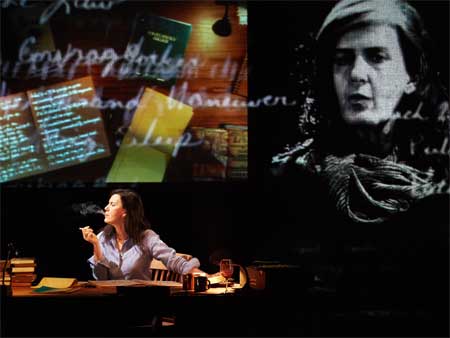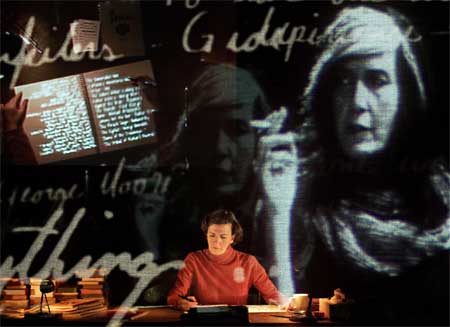Play, Performance Piece with Film
By The Builders Association
Based on the books
Reborn and As Consciousness is Harnessed to Flesh
by Susan Sontag, edited by David Rieff
Directed by Marianne Weems
Adapted and Performed by Moe Angelos
ArtsEmerson
Paramount Theatre, Boston, MA
May 6 – 18, 2014

in “Sontag: Reborn”
Photo: James Gibbs
Courtesy of ArtsEmerson
Susan Sontag (1933-2004) was an influential American philosopher, novelist, essayist and critic. Innovative and daring, she lived an intellectually passionate life and wrote on a broad array of subjects.
This strikingly good performance piece is acted by Moe Angelos in concert with a brilliantly conceived and orchestrated array of film and video montages.
This eighty-five minute work, performed without intermission, is chronologically organized, beginning with Sontag’s early youth and stretching through part of her adult life.
Angelos’ interpretation of Sontag, as she moves from an intellectually precocious young teenager through young adulthood, is astute and incisive. She captures threads of aspirational scholarship, insightful analysis, sarcastic invective, and passionate yearning that carry through the arc of Sontag’s journals, while also evolving a portrait of Sontag emerging into the intellectual sophistications, the passions and challenges of womanhood.
Indeed, Sontag grew up very young. As a sixteen year old student at the University of Chicago, she became engaged and married to sociologist Philip Rieff and not long afterwards bore him a son, David. But Sontag was driven to pursue her intellectual aspirations and continued, despite family turmoil, to continue her studies at Harvard, Columbia, Oxford and at the University of Paris.
The ingenuity of this production is to have, for most of its duration, a larger than life projection of Sontag as an older woman, also acted by Angelos, on the right center forefront of the stage, providing ongoing commentary and narration. Meanwhile, Angelos herself sits at a desk behind the forward projection scrim and, in continuing interaction with the projected figure, gives a vivid sense of more than one character onstage. At one point, humorously, impressive technically, the projected Sontag flicks her cigarette ashes into an ashtray that sits on the corner of the live Sontag’s desk.
As well, behind Angelos is another screen which largely shows a projection of a written text being inscribed as the narration unfolds, but which doubles to display wittily embellished scenes related to the narrated drama.
The musical rhythms of these three arenas of live action and dual projected images gives a powerful sense of the anguish, drama and intensity of Sontag’s life.
At the very end, when the video becomes even more kinetic in its rendering of Sontag’s body of work, it coheres every corner of the stage into its projected swirl. It is a moving and dramatic finale.

in “Sontag: Reborn”
Photo: James Gibbs
Courtesy of ArtsEmerson
The entire text is adapted, by Moe Angelos, from Sontag’s journals. The selection and editing is deftly done in such a way that the swirl of Sontag’s life is condensed into this short play, giving a vivid sense of the trajectory of her passions and the evolution of her intellectual drive.
Punches are not pulled. We get to see Sontag as a young mother and not always a great one. And we get a window into her frustrated life as wife and into her passionately driven, but often, turbulent involvements as a lesbian. Always outspoken and clear in her journals about even the most intimate moments, Sontag gives a brilliant account of her own complicated doings and the dramatization translates it without diminution of intensity.
Angelos and The Builders Association, including the brilliant video design by Austin Switser and Jesse Garrison, have produced a concise, beautifully constructed, performance that provides an unobstructed, but inventively framed, view into the life of one of the twentieth century’s notably enigmatic intellectuals.
– BADMan
Leave a Reply